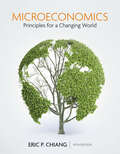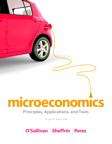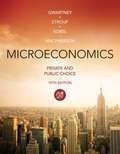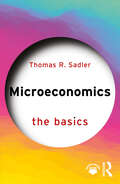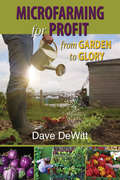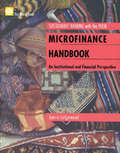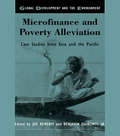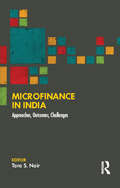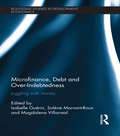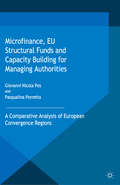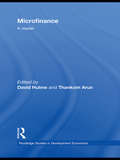- Table View
- List View
Microeconomics: Principles for a Changing World
by Eric ChiangWith this edition, Eric Chiang continues to link economics concepts to topics of personal interest to students. The new edition is a thoroughly contemporary, fully integrated print/technology resource that adapts to the way you want to teach. As always, this concise book focuses on the topics most often covered in the principles course, but with this edition, it offers a stronger emphasis than ever on helping students apply an economic way of thinking to the overwhelming flow of data we face every day. Economics: Principles for a Changing World is fully informed by Eric Chiang’s experiences teaching thousands of students worldwide, both in person and online. Developing the text, art, media, homework, and ancillaries simultaneously, Chiang translates those experiences into a cohesive approach that embodies the book’s founding principles: To use technology as a tool for learning—before lectures, during class, when doing homework, and at exam time To help students harness the data literacy they’ll need as consumers of economic information
Microeconomics: Principles, Applications, and Tools (Eighth Edition)
by Arthur O'Sullivan Steven M. Sheffrin Stephen J. PerezFor Principles of Microeconomics courses. Microeconomics: Principles, Applications, and Tools, is also suitable for economists, financial analysts and other finance professionals. Questions that drive interest, applications that illustrate concepts, and the tools to test and solidify comprehension. Students come into their first Economics course thinking they will gain a better understanding of the economy around them. Unfortunately, they often leave with many unanswered questions. To ensure students actively internalize economics, O'Sullivan/Sheffrin/Perez use chapter-opening questions to spark interest on important economic concepts, applications that vividly illustrate those concepts, and chapter-ending tools that test and solidify understanding.
Microeconomics: Private and Public Choice (Fifteenth Edition)
by James D. Gwartney David A. Macpherson Russell S. Sobel Richard L. StroupMICROECONOMICS: PRIVATE AND PUBLIC CHOICE, Fifteenth Edition, reflects current economic conditions, enabling you to apply economic concepts to the real world. The up-to-date text includes analysis and explanation of measures of economic activity in today's market. It also includes highlights of the recession of 2008-2009, and an in-depth look at the lives and contributions of notable economists. MICROECONOMICS: PRIVATE AND PUBLIC CHOICE dispels common economic myths. The text uses the "invisible hand" metaphor to explain economic theory, demonstrating how it works to stimulate the economy. The fifteenth edition includes online learning solutions to improve your learning outcomes. Graphing tutorials and videos embedded within the interactive reader support your classroom work and improve your performance.
Microeconomics: Static and Dynamic Analysis (Springer Texts in Business and Economics)
by Krzysztof Malaga Karolina SobczakThis book provides a comprehensive overview of the fundamental concepts and principles of microeconomics. It introduces students to the models, assumptions, and empirical applications of modern microeconomics, as well as to the necessary mathematical tools. It covers topics such as economic behavior, consumer theory, theory of the firm, partial and general equilibrium theory, industrial organization, bargaining theory, and Pareto optimality. Students learn not only about economic outcomes at a given point of equilibrium, but also about dynamic economics, which includes both equilibrium and disequilibrium.This book is intended for undergraduate and graduate students in economics and related fields who are interested in the basic theories and applications of microeconomics.
Microeconomics: The Basics (The Basics)
by Thomas R. SadlerMicroeconomics: The Basics is an accessible introduction to the core topics in the field. Intended for those with little or no background in the subject, it provides the reader with a solid foundation of the basic principles of microeconomics and establishes a framework for further study.Topics in the book cover the most important areas in microeconomics, including supply and demand, consumer choice, elasticity, market failure and the role of government, production and cost, perfect competition, monopoly, oligopoly, monopolistic competition, the labor market, and capital and financial markets. Applications that are relevant for contemporary study of the field are also included. Written in a highly engaging style, each chapter is accompanied by key terminology lists to emphasize important terms and concepts, as well as further reading suggestions which provide the opportunity for students to read more about specific topics, with a glossary provided at the end of the book.Microeconomics: The Basics is essential reading for anyone who wishes to master the fundamental principles of microeconomics.
Microeconomics: Theory and Applications with Calculus
by Jeffrey M. PerloffFor all intermediate Microeconomics courses at the undergraduate or graduate level. This text is also suitable for readers interested in calculus-based intermediate microeconomics. <P><P> Understand the practical, problem-solving aspects of microeconomic theory. Microeconomics: Theory and Applications with Calculus uses calculus, algebra, and graphs to present microeconomic theory using actual examples, and then encourages readers to apply the theory to analyze real-world problems. The Third Edition has been substantially revised, 80% of the Applications are new or updated, and there are 24 new Solved Problems. Every chapter (after Chapter 1) contains a new feature (the Challenge and the Challenge Solution) and has many new end-of-chapter exercises.
Microempresa, Megavida: Cinco pasos para una gran vida a través de tu pequeña empresa
by Louis BarajasNo permitas que tu negocio controle tu vida; administra tu negocio de tal forma que te dé a ti y a tu familia una buena vida.Crear y ser dueño de una empresa exitosa es parte del sueño estadounidense. Microempresa, Megavida, escrito para "la persona común y corriente que tiene más sueños que educación, capital o recursos" promete guiarte a obtener no sólo el éxito en el ámbito profesional y financiero sino también una vida satisfactoria. Louis Barajas nos muestra cómo crear un negocio que enriquezca tu vida al igual que tu billetera, que genere dinero y significado y que provea un legado para ti y tu familia.Barajas utiliza un excepcional enfoque integral que trata con la vida y también los negocios. Los cuatro pilares para tener una gran vida obtenida por medio de una pequeña empresa son: la verdad, la responsabilidad, el estar consciente y el valor. Los cinco pasos para desarrollar una pequeña empresa que te darán una gran vida son:El plano de tu vidaTu visiónEl plano de tu negocioLos sistemas de tu negocioTu equipo
Microentrepreneurship in a Developing Country: Evidence for Public Policy
by Jagannadha Pawan TamvadaThis book examines the nexus between the entrepreneur, the firm, and the region for drawing a comprehensive picture of entrepreneurship in a developing country context. It emphasizes the role of the spatial location in simultaneously determining the occupational choice at an individual level and the nature of new firm start-ups emerging in a region. In doing so, the author provides a novel approach to examining entrepreneurship in emerging economies. Using large-scale databases from India, the book offers fresh insights for shaping public policy in developing countries that aim to pursue entrepreneurship led growth.
Microfarming for Profit
by Dave Dewitt"This useful, entertaining guide gives prospective microfarmers the dirt on realistic essentials for turning a garden into a money-making enterprise...The author advises on such basics as business plans and sales techniques; profiles a range of actual working microfarms, from flowers to killer bees; and relates hilarious stories from his own microfarming."-PUBLISHERS WEEKLYWith wit, expertise, and common sense, Dave DeWitt shows you how to establish a successful microfarm by choosing the most profitable plants and animals to raise and learning to market and sell what you produce. His informative yet conversational style makes you feel you're talking with an expert you already know.Declared the "pope of peppers" by the New York Times, Dave DeWitt is one of the foremost authorities on chile peppers and spicy foods. A food historian and prolific writer, he is the author of over fifty books including gardening guides, food histories, and cookbooks. DeWitt is an associate professor in the College of Agriculture, Consumer, and Environmental Sciences at New Mexico State University, and co-producer of the National Fiery Foods and Barbecue Show, now in its twenty-sixth year. Dave lives with his wife in Albuquerque, New Mexico.
Microfinance Handbook
by Joanna LedgerwoodMicrofinance is not simply banking; it is a development tool. It has been estimated that there are 500 million economically active poor people in the world operating microenterprises and small businesses. Most of them do not have access to adequate financial services. The purpose of this Handbook is to bring together in a single source guiding principles and tools that will promote sustainable microfinance and create viable institutions. The Handbook takes a global perspective, drawing on lessons learned from the experiences of microfinance practitioners, donors, and others throughout the world.This volume covers extensively matters pertaining to the regulatory and policy framework and the essential components of institutional capacity building, such as product design, performance measuring and monitoring, and management of microfinance institutions.The handbook has three parts. 'Issues in Microfinance Provision' - Part I, takes a macroeconomic perspective toward general microfinance issues and is primarily nontechnical. 'Designing and Monitoring Financial Products and Services' - Part II, narrows its focus to the provision of financial intermediation, taking a more technical approach and moving progressively toward more specific (or micro) issues. 'Measuring Performance and Managing Viability' - Part III, is the most technical part of the handbook, focusing primarily on assessing the viability of microfinance institutions.
Microfinance Institutions
by Roy Mersland R. Øystein StrømUntil recently most microfinance research focused on whether access to finance is beneficial for economically poor entrepreneurs and families. The industry has now grown big and Microfinance Institutions (MFIs) serves hundreds of millions of customers. The business of microfinance is therefore becoming an important research area. While performance and efficiency studies are common in banking research such research on MFI performance is still in its infancy. MFI performance studies are challenging because they are hybrid organizations with dual objectives of serving low-income customers while being financially sustainable. This book contains a collection of new MFI performance research by top scholars from across the globe. A wide range of topics are covered including cash-flow analyses, cultural influence, mission-drift, the influence of public regulation and international actors, group lending, competition, ownership issues, earnings management as well as traditional efficiency studies.
Microfinance and China's Regional Development: The Case of Luqiao
by Wen Xiao Jiadong Pan Wenwu XieThis book focuses on the innovative development of microfinance in China and takes Luqiao District, Taizhou as the example to sum up Chinese experiences in the local innovative development of microfinance and the application of that experience nationwide. Based on theoretical research regarding microfinance, this book analyzes the history and current situation of the development of microfinance in Luqiao District, and places emphasis on proceeding from three-pronged positioning, five characteristics and three major modes of microfinance’s innovative development in Luqiao District to explore and summarize the Luqiao story of microfinance. Subsequently, this book takes five perspectives—the innovative development of small and medium-sized banks, the innovative development of non-banking financial institutions, the roles of private capital, the policies of the local government and cooperation between the Chinese Mainland and Taiwan—to analyze the experience and paths for helping the development of small and micro enterprises. Finally, based on the conclusions of the research, this book presents some inspirations from the innovative development of microfinance in Luqiao District and future prospects. This book will interest economists, scholars of China’s economic model, and banking sector analysts.
Microfinance and Financial Inclusion in India: The NABARD Story
by G. R. Chintala Rajendrakumar ThanviThe success of microfinance in the last three decades has shown that if given adequate infrastructural and governmental aid, the poor can be bankable. Microfinance and Financial Inclusion in India traces the origin of microfinance in India and examines its growth, delivery and institutional models, and the challenges it faces. It advocates more engagement with the poor clientele through an appropriate product and process mix that could contribute meaningfully to India's economic development. The book also looks into the trailblazing initiatives launched by the National Bank for Agriculture and Rural Development (NABARD) to promote microfinance and inclusive banking services. It explores self-help groups and joint liability groups that can leverage social capital to support microentrepreneurs and small farmers with adequate and timely institutional credit. This book captures the fascinating journey of Indian microfinance by delving into NABARD's work, the use of technology to transform banking for the poor and the dream of universal financial access.
Microfinance and Financial Inclusion: The challenge of regulating alternative forms of finance (Routledge Research in Finance and Banking Law)
by Eugenia MacchiavelloFollowing the recent global financial crisis there is a growing interest in alternative finance – and microfinance in particular – as new instruments for providing financial services in a socially responsible way or as an alternative to traditional banking. Nonetheless, correspondingly there is also a lack of clarity about how to regulate alternative financial methods particularly in light of the financial crisis’ lessons on regulatory failure and shadow banking’s risks. This book considers microfinance from a legal and regulatory perspective. Microfinance is the provision of a wide range of financial services, particularly credit but also remittances, savings, to low-income people or financially excluded people. It combines a business structure with social inspiration, often resorts to technological innovations to lower costs (Fintech: e.g. crowdfunding and mobile banking) and merges with traditional local experiences (e.g. financial cooperatives and Islamic finance), this further complicating the regulatory picture. The book describes some of the unique dimensions of microfinance and the difficulties that this can cause for regulators, through a comparative analysis of selected European Union (EU) countries’ regimes. The focus is in fact on the EU legal framework, with some references to certain developing world experiences where relevant. The book assesses the impact and validity of current financial regulation principles and rules, in light of the most recent developments and trends in financial regulation in the wake of the financial crisis and compares microfinance with traditional banking. The book puts forward policy recommendations for regulators and policy makers to help address the challenges and opportunities offered by microfinance.
Microfinance and Poverty Alleviation: Case Studies from Asia and the Pacific (Global Development And The Environment Ser.)
by Benjamin Quiñones Joe RemenyiFirst published in 2000. Routledge is an imprint of Taylor & Francis, an informa company.
Microfinance in Developing Countries
by Ronny Manos Jacob Yaron Jean-Pierre GueyieMicrofinance in developing countries is a collection of studies by leading researchers in the field of microfinance. It discusses key issues that the rapidly growing microfinance industry currently faces, and offers interesting views and analysis of topical matters concerning the microfinance realm.
Microfinance in India 2010-2016: Crisis and Recovery
by Shawn Cole Yannick Saleman Caitlin Reimers Vikram GandhiSKS, India's leading microfinance firm, is challenged when politicians declaim microfinance as exploitation of the poor and severely restrict business practices.
Microfinance in India: Approaches, Outcomes, Challenges
by Tara S. NairThis volume presents a comprehensive analysis of microfinance initiatives in India. Through substantive field research and case studies ranging across the country, it examines Indian microfinance within its distinct socio-economic realities — the role of women, financial inclusion, rural entrepreneurship, and innovation — its interactions with multiple institutions, the challenges, as well as future directions.
Microfinance to Combat Global Recession and Social Exclusion: An Empirical Investigation
by Ramesh Chandra DasThe book focuses on how microfinance institutions can be the alternative way to supply funds to combat different phases of global economic recessions. Also, it emphasizes upon their capabilities in reducing poverty and inequality as the countries of the world today aim to attain the goal of sustainable development. The book further deals with the challenges that the micro financial institutions may face while sustain in the competitive and vast changing global business environment. Finally, the book analyses the effectiveness of micro financial services for the emergence of micro, small and medium enterprises with new technology and innovations which, in turn, can be instrumental in ensuring new relocation of global supply chains.
Microfinance, Debt and Over-Indebtedness: Juggling with Money (Routledge Studies in Development Economics)
by Isabelle Guérin Solène Morvant-Roux Magdalena VillarrealAlthough microcredit programmes have long been considered efficient development tools, many forms of debt-induced distress have emerged in their wake. This has brought to light the problem of over-indebtedness, a topic which has been previously underexplored in the literature. This new book, from a group of leading scholars, explores the manifestations, scale, and economic and social implications of household over-indebtedness in areas conventionally considered as financially excluded. The book approaches debt not only as a financial transaction, but also as a form of social bond, and offers a socioeconomic analysis of over-indebtedness. The volume puts forward a broad definition of over-indebtedness, highlighting its situational and semantic complexity and diversity. It provides a close analysis of local conceptions of debt and over-indebtedness, highlighting frameworks of calculation and the constant renegotiation of their boundaries. On top of this, it looks far beyond microcredit to examine all the financial practices that individuals juggle. The volume argues that over-indebtedness has more to do with social inequalities than financial illiteracy, and should therefore be understood in the light of global trends of financialization. It also reveals the ambiguity of "financial inclusion" policies, and in many respects questions the actions of new credit providers. This book will be valuable reading for students, researchers and policy makers interested in microfinance and development issues.
Microfinance, EU Structural Funds and Capacity Building for Managing Authorities: A Comparative Analysis of European Convergence Regions (Palgrave Studies In Impact Finance)
by Pasqualina Porretta Giovanni Nicola PesMicrofinance, EU Structural Funds and Capacity Building for Managing Authorities.
Microfinance, EU Structural Funds and Capacity Building for Managing Authorities: A Comparative Analysis of European Convergence Regions (Palgrave Studies in Impact Finance)
by Pasqualina Porretta Giovanni PesIn recent years, the European Commission has attached increasing importance to the use of financial engineering instruments rather than traditional grant-based financing for the microcredit sector, considering these to be the most efficient option available. This book presents a study of capacity building and structural funds in public managing authorities for the microcredit sector. It presents two surveys to highlight the strengths and weaknesses of the managing authorities' capacity building. The first survey investigates the authorities' need for and interests in capacity building activities, assessing the areas in which capacity building support is needed, and explores the different types of support offered. The second survey analyses the results of the microcredit and microfinance programming activity, investigating its target groups and other operational features. It examines the key monitoring and reporting issues involved in this activity, before analysing the regulatory framework of the microcredit and microfinance sector. This book presents an in-depth analysis of structural funds and their management by policy-makers in the European convergence regions. It explores the interests of managing authorities, microcredit institutions, operators and other financial intermediaries involved in microcredit programming activities, and offers some core strategic and operational recommendations for the use of structural funds in the microcredit sector.
Microfinance, Livelihoods and Poverty Reduction in Ghana (Routledge Studies in African Development)
by Aaron AlesaneThis book assesses the role of microfinance in the construction of livelihoods for poverty reduction in the Northern Savannah of Ghana, analysing the current microfinance landscape and financial services in the region. The book analyses the current microfinance landscape and financial services in Ghana. In doing so, it demonstrates the key factors for designing microfinance products and services to ensure greater uptake and outreach enhancing the sustainability of microfinance service providers. Chapters explore the impact of access to microfinance on livelihood diversification, asset accumulation patterns and welfare outcomes. In addition to assessing the role as well as of microfinance as an anti-poverty tool, the book presents new theoretical frameworks and models, including the microfinance livelisystem framework (MFL). This unique framework, which combines and goes beyond existing frameworks, situates the microfinance industry within national and international financial and economic ecosystems and presents the interrelationships between institutions providing services for the construction of livelihoods. Offering new theoretical frameworks and models developed for the microfinance industry with universal application, this book will be of particular use to students and scholars of Development Studies, Development Finance, Poverty and Inequality Studies, Rural Development and Sustainable Finance.
Microfinance, Risk-taking Behaviour and Rural Livelihood
by Amit K. Bhandari Ashok KunduThis book offers an in-depth analysis of borrowing and risk taking behavior of rural people, with the aim of designing effective financial products and service delivery in the rural market. Includes analysis of government schemes to promote rural development.
Microfinance: A Reader (Routledge Studies in Development Economics)
by David Hulme Thankom ArunMicrofinance has become an important component of development, poverty reduction and economic regeneration strategy around the world. By the early twenty first century tens of millions of people in more than 100 countries were accessing services from formal and semi-formal microfinance institutions (MFIs). Much of the initial attention on microcredit came through work on Bangladesh’s much-lauded Grameen Bank but, there are now many different ‘models’ for microfinance and many countries have substantial microfinance sectors. This timely book, written by one of the major players in the UK in development economics explores, amongst others, topics such as: microfinance and poverty reduction microfinance, gender and social development microinsurance regulating and supervising microfinance institutions. Topical and insightful, this important text examines what has become a vast global industry employing hundreds of thousands of people and attracting the attention of large numbers of governments, banks, aid agencies, non-governmental organizations and consultancy firms.
